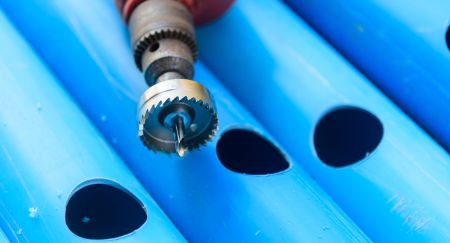Will a Hole Saw Cut Through Plastic?
Hole saws are extremely versatile drill bits that are used to create smooth, clean, large holes in a variety of materials. They are often used in woodworking, however, they can also be used to make holes in plastic and even metal. Thanks to their sharp edges that can easily cut through your workpiece, hole bits require minimal pressure, reducing the risk of melted plastic or jagged edges. For materials such as plastic, they can be used to make holes of various sizes. With that said, the thickness and type of plastic make all the difference in how well hole saws cut through plastic. These bits also need to be used carefully to ensure that plastic does not melt or crack. In this guide, we’ll share some tips on how to use hole bits on plastic for the best results.
Can Hole Saws Drill Through Plastic?
Are hole saws the best choice to drill through plastic? Ultimately, this depends on the type of hole you need to make. These bits are made to drill straight through material. They have a hollow centre that removes the core cleanly. An arbor is used alongside the bit to keep it in place, ensuring an accurate, perfectly even hole. If you need to create a very small hole in plastic, other bits such as an HSS Metal HSS Step Bit, Standard Metal HSS Bit or a Multi-Purpose Bit can get the job done. If you need to make larger-sized holes in plastic, a hole bit is your best option.
Things you’ll need to keep in mind when using hole bits on plastic include the following:
- Always choose the right size saw. Using a bit that is too small will not get through the plastic, increasing the risk of overheating if you try and force the bit through. Using one that is too large will damage the material you are drilling, increasing the chance of melting and cracks. If you’re not about size, measure the hole you need to make and then choose your bit from there.
- Set your drill speed properly. Whatever bit you are using, drilling plastic takes patience. Drilling at high speeds increases the risk of overheating, which in turn results in a melted or cracked workpiece. Drilling too slow, on the other hand, means that the bit will tear through your material, without making clean holes.
- Drill carefully using even pressure. Using even pressure means that you will not damage the teeth of the saw. When drilling, you want to stand directly over the drill so that the holes are vertical. From there, you need to make a small dent to mark the centre, place the arbor onto the dent and then drill through using even pressure.
- Use coolant and lubricant when drilling. Plastic can be tricky to work with - especially if you haven’t worked with it before. As it can easily melt, using coolants is essential. Avoiding overheating is the simplest way to keep your holes clean, without any rough edges caused by melted chips. Keeping your bit lubricated will also help to ensure a clean cut.
- Know which plastics are suitable for this bit. While hole saws can be used on most types of plastic, they are not suitable for extremely hard or thick plastics. Using a hole bit on heavy-duty plastic can damage the bit, the material and your drill. For thin and medium plastics, a Standard Bi-Metal Hole Saw is ideal. An Industrial Bi-Metal Hole Saw will get through tougher plastics.
Ruwag offers a selection of high-quality hole saws and arbors for every project, helping you get the best results when drilling plastic and other materials.

